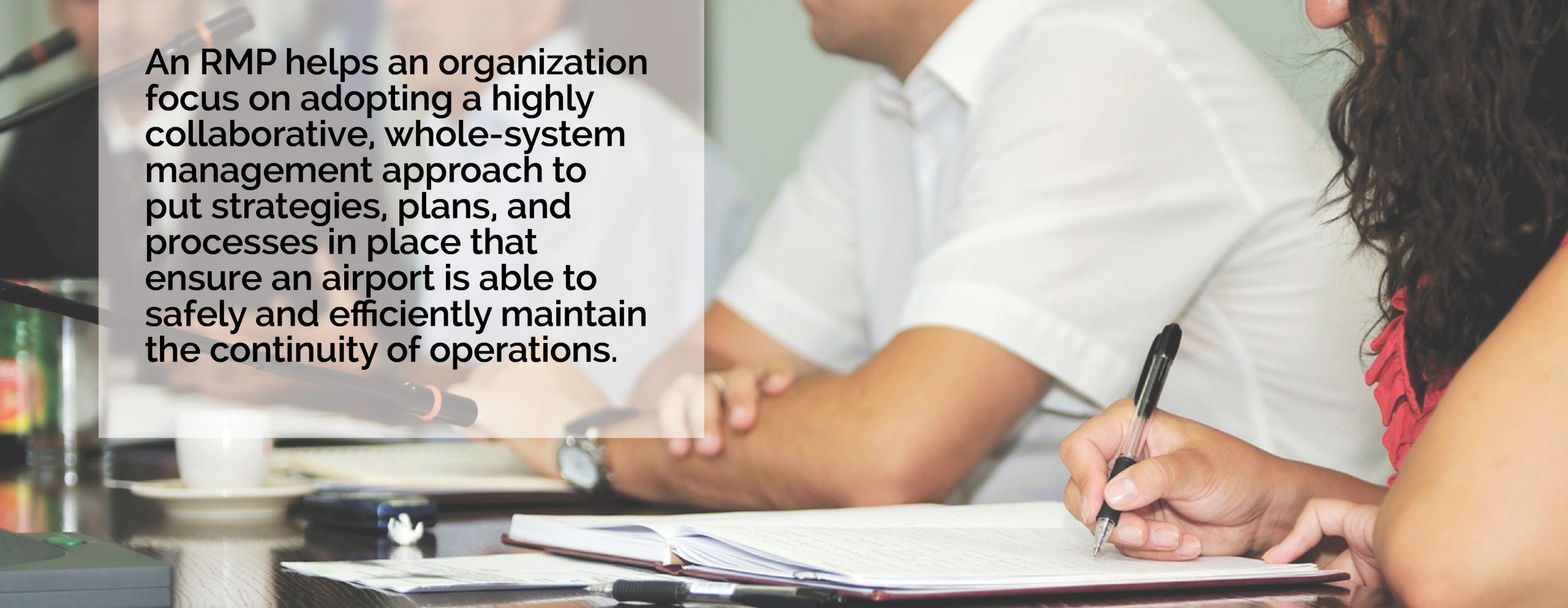An RMP can be developed from scratch or it can be a logical evolution of an existing sustainability plan, master plan, or strategic plan.
However, the following is important to note:
- Master and strategic plans are useful tools to developing a thorough understanding of key current and future issues and to providing a strategic roadmap for future capital development, but they are, effectively, static snapshots in time. Airports are constantly confronting change, thus requiring on-going, dynamic operational management—including sustainability and resilience concerns—to be captured in a management plan.
- Sustainability plans usually include dozens of daily decision-related measures, which can often result in numerous (and sometimes unexpected) follow-up initiatives; therefore, a management system framework is needed to manage downstream decisions.
An RMP Should Include:
-
- Strategy and Visioning
- Analysis and Assessment
- Planning and Documentation
- System Development
- Processes for Reviews and Updates
These observations closely align with the FAA’s recent shift from a “one-size-fits-all” master plan approach to the issuance of both updated planning and guidance documents and new guidance focused on the daily and proactive management of challenges. There is inherent value in the master plan process, but there must also be a robust and comprehensive management system. As such, an RMP should integrate and leverage the strengths from both planning approaches.
An RMP should be developed and implemented in a multi-phase approach, enabling an airport to simultaneously: (1) engage in actions that will facilitate organizational culture change and (2) educate internal and external stakeholders and generate buy-in.
Stakeholders
An RMP helps an organization focus on adopting a highly collaborative, whole-system management approach to put strategies, plans, and processes in place that ensure an airport is able to safely and efficiently maintain the continuity of operations. Because RMP development can be a complex and lengthy process, it requires the collaboration of not only multiple departments across the airport organization, but also with airport tenants and consortiums and other key external stakeholders, which may include:
- FAA’s Airports District Office
- Communities surrounding the airport
- Regional planning organizations
- Department of Homeland Security
- State department of transportation
Engagement should include outreach (e.g., workshops) to educate all stakeholders likely affected by the outcomes of the RMP on the principles of resilience. These touchpoints can provide an opportunity to develop a shared understanding of critical planning milestones and to solicit feedback/input related to the focus areas, strategies, and management plan. Engagement sessions should also involve coordination with other entities and airport users that may already have, or are in the process of developing, similar plans.

Risk Management
Current resilience-based planning efforts generally tend to focus on ‘shock events’ rather than ‘chronic stressors,’ which are a critical element of resilience planning. Resilience thinking should address both known risks, as well as identifying new or previously unidentified risks. An RMP’s intended approach to risk assessment and management should be generally consistent with the U.S. Department of Transportation’s pilot program, which created a risk model to evaluate the resilience of the numerous assets overseen by the Federal Highway Administration.
An RMP should empower users to proactively look to identify, understand, and mitigate risks to avoid operational incidents. The ability to understand risks and the resources required to mitigate those risks strengthens the strategic capital planning process. Managing risk requires understanding both the probability of an eventual system failure and the system impact of failure, and the outcome of creating that comprehensive risk understanding directly supports management decision-making for allocating scarce resources.
Conceptual Principles
Every airport is different, with each having their own unique considerations and associated priorities. However, the following principles would inform the basis for developing an RMP at any airport:
- Project Framework
- RMP Visioning
- Inventory of Strategic Assets and Infrastructure
- Determine Requirements
- Risk Assessment
- Identify Strategic Focus Areas
- Develop Focused Management Plans and Processes
- Stakeholder Outreach
- Develop a System for Resilience Management
- Develop Resilience Promotion/Education Programs
- Develop Electronic Resilience Management Tools
- Structure for Regular Reviews
It is important to note that, while developing and implementing an effective RMP may seem like a daunting and expensive endeavor, it is a scalable and airport-specific process. Each airport and the challenges it faces will be different. For example, many of the risks associated with operating the world’s busiest airport will likely not be the same as those associated with a small-hub airport, and where there is alignment, the magnitude of those issues will likely be vastly different. What won’t change, regardless of organization size, are the fundamentals of the resilience planning process, which include: strategy and visioning; analysis and assessment; planning and documentation; system development; and processes for reviews and updates.
This is the final installment of our three-part blog series that included a definition of airport resilience and what should be covered in a resilience management plan. If you would like to read the series in its entirety, click here to download a PDF. Please reach out to our airports resilience specialist, Neal Wolfe, with any questions or comments.








